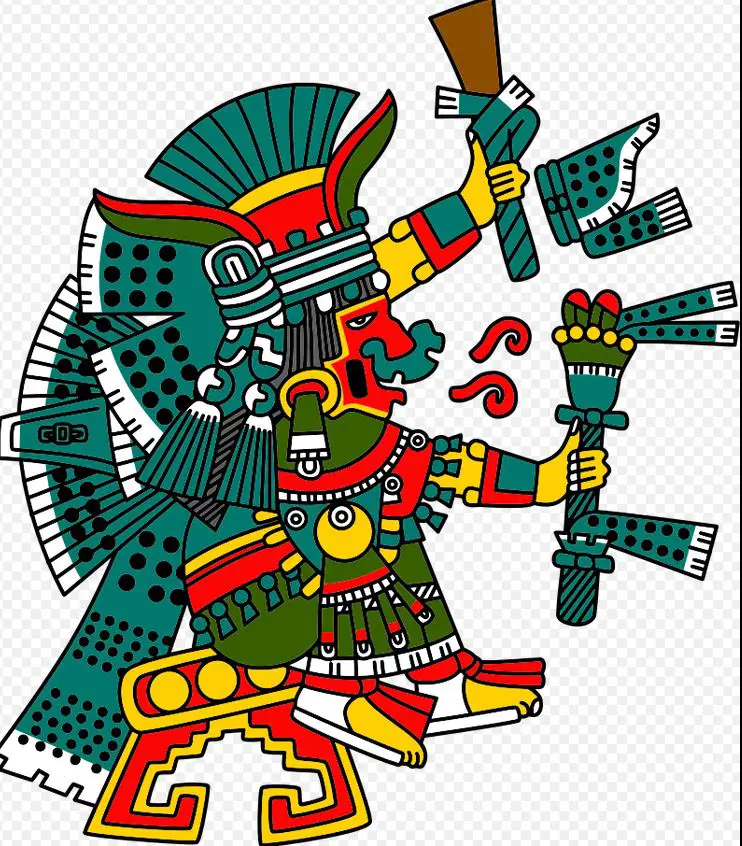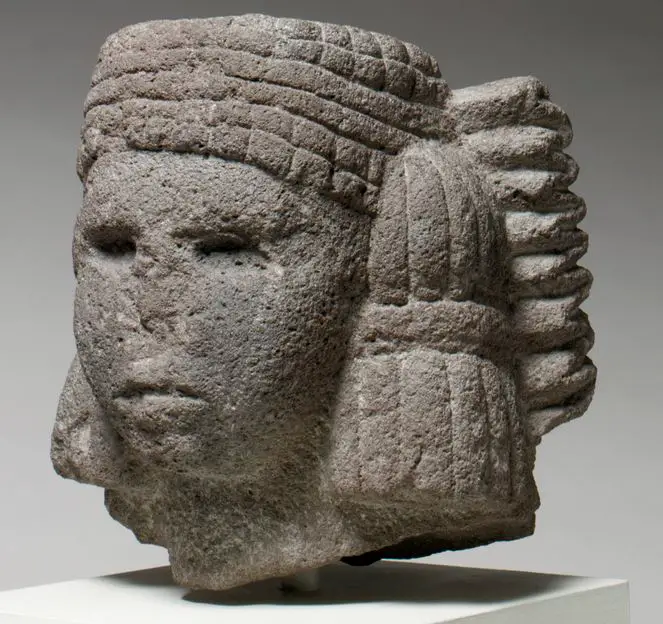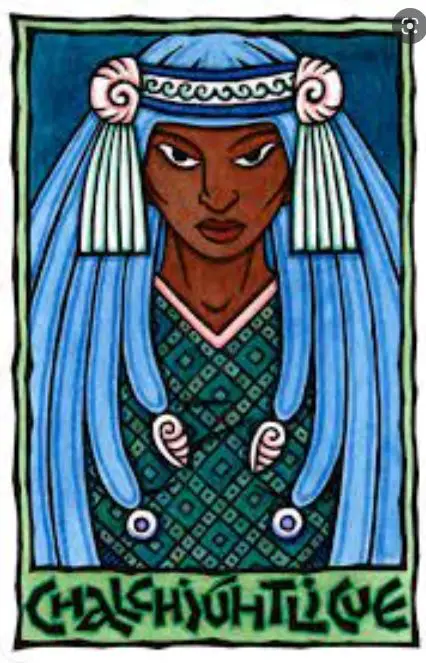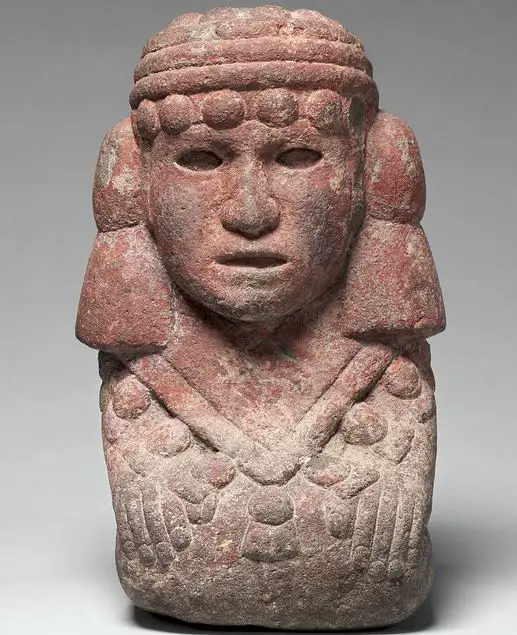Podcast: Play in new window | Download
Subscribe: Apple Podcasts | RSS
 It’s a story that’s been told for over a thousand years. The Fourth Sun, or fourth existence ever created, was ruled over by a very powerful feminine presence. Most people in central Mexico called her Chalchiuhtlicue and while kind and nurturing, she could also be a force to be reckoned with. She was called by other names among the ancient Mexicans. Sometimes she was referred to as Chalchiuhtlatonac or Matlalcueye. When the third existence or the Third Sun was burned to ashes Chalchiuhtlicue and the other gods and spirits created the new Fourth Sun, or fourth existence which Chalchiuhtlicue would rule over. The Aztecs called this Fourth Sun Nahui-Atl, or “The Water Sun.” All the ancient Mexican stories involving the gods and other supernatural forces and aspects have variety to them, and this has to do with some cultural groups evolving isolated from one another over time. An Aztec emperor called Ahuizotl tried to standardize religion throughout the Aztec Empire in the late 1400s, but many non-standardized varieties of the official Aztec religious dogma persisted. In the official story, Chalchiuhtlicue was a benevolent goddess presiding over the fourth existence of creation, or the Fourth Sun, and she loved the people of the earth whom she saw as her children. The god Tezcatlipoca did not approve of the reign of Chalchiuhtlicue and claimed that her affection for the people of the earth was fake. She feigned this affection, he asserted, out of selfishness and vanity because she just wanted to be worshipped. Chalchiuhtlicue was so distraught by these accusations that she cried tears of blood. She cried for 52 years and flooded the whole earth. Because of this, people turned themselves into fish in order to survive. The floods from Chalchiuhtlicue eventually destroyed the whole world and ushered in a new one, the Fifth Sun, which is the existence we currently live in. Another version of the story, a more unofficial version, does not portray Chalchiuhtlicue as being so delicate as to be so easily hurt by others’ words. As ruler of the Fourth Sun, or Nahui-Atl, Chalchiuhtlicue called up the waters and destroyed existence on purpose because she was angry with people and wanted to demonstrate her power to the other gods and goddesses. Researching the Aztec creation stories can be a bit confusing, and many legends seem to contradict each other. Many 16th Century documents were written from word-of-mouth stories that had been passed down for generations and show great variety according to the region of Mexico in which they were found.
It’s a story that’s been told for over a thousand years. The Fourth Sun, or fourth existence ever created, was ruled over by a very powerful feminine presence. Most people in central Mexico called her Chalchiuhtlicue and while kind and nurturing, she could also be a force to be reckoned with. She was called by other names among the ancient Mexicans. Sometimes she was referred to as Chalchiuhtlatonac or Matlalcueye. When the third existence or the Third Sun was burned to ashes Chalchiuhtlicue and the other gods and spirits created the new Fourth Sun, or fourth existence which Chalchiuhtlicue would rule over. The Aztecs called this Fourth Sun Nahui-Atl, or “The Water Sun.” All the ancient Mexican stories involving the gods and other supernatural forces and aspects have variety to them, and this has to do with some cultural groups evolving isolated from one another over time. An Aztec emperor called Ahuizotl tried to standardize religion throughout the Aztec Empire in the late 1400s, but many non-standardized varieties of the official Aztec religious dogma persisted. In the official story, Chalchiuhtlicue was a benevolent goddess presiding over the fourth existence of creation, or the Fourth Sun, and she loved the people of the earth whom she saw as her children. The god Tezcatlipoca did not approve of the reign of Chalchiuhtlicue and claimed that her affection for the people of the earth was fake. She feigned this affection, he asserted, out of selfishness and vanity because she just wanted to be worshipped. Chalchiuhtlicue was so distraught by these accusations that she cried tears of blood. She cried for 52 years and flooded the whole earth. Because of this, people turned themselves into fish in order to survive. The floods from Chalchiuhtlicue eventually destroyed the whole world and ushered in a new one, the Fifth Sun, which is the existence we currently live in. Another version of the story, a more unofficial version, does not portray Chalchiuhtlicue as being so delicate as to be so easily hurt by others’ words. As ruler of the Fourth Sun, or Nahui-Atl, Chalchiuhtlicue called up the waters and destroyed existence on purpose because she was angry with people and wanted to demonstrate her power to the other gods and goddesses. Researching the Aztec creation stories can be a bit confusing, and many legends seem to contradict each other. Many 16th Century documents were written from word-of-mouth stories that had been passed down for generations and show great variety according to the region of Mexico in which they were found.
 Besides being the ruler and destroyer of an entire universe of existence, who was Chalchiuhtlicue? Many references state that the word Chalchiuhtlicue means “She of the Jade Skirt,” in the language of the Aztecs, Nahuatl. A modern take on her name, reinterpreted by Professor Arturo Montero of the Autonomous University of Mexico, or UNAM, has this name meaning, “Woman of the Skirt of Greenish Precious Stones.” The professor claimed that the ancient meaning of the word chalchihuitl means “precious greenish stone” and was not used specifically to identify jade. It could be used to include serpentine and even turquoise. A cueitl, in Nahuatl, was a type of skirt worn by high status women and often depicted as part of the wardrobe of many ancient Mexican goddesses. Dr. Montero believes that the use of the word “jade” instead of “precious stones” in Chalchiuhtlicue’s name was a simple mistake that was repeated over time. In any case, the goddess is often depicted wearing jade, along with other jewels, because of the importance jade held in ancient Mesoamerica. The stone is also close to the color of water, which Chalchiuhtlicue represents, and the greenish stones studding her skirt are said to represent drops of water. The goddess is often depicted with a yellow face and wears an elaborate headdress tied off in a band made of cotton and bones. She wears a necklace of jewels and intricate earrings. In most interpretations Chalchiuhtlicue wears a white skirt studded in jade along with a triangular napkin draped about her shoulders. Her throne is a simple seat upholstered in jaguar skins. As with the variety expressed in the stories surrounding her, the image of Chalchiuhtlicue changes over time and depends on the region of Mexico in which she is found. When the Spanish first encountered this goddess, they called her “Magna Mater”, which means in Latin, “Great Mother,” because in the final days of the Aztec Empire, illustrations often depicted Chalchiuhtlicue as breastfeeding a human while sitting on an elaborate throne. In other images – such as the one found in the famous Florentine Codex – the goddess is wearing a shield and carries a weapon, giving Chalchiuhtlicue a military look, emphasizing her potential as a destructive power. In some cases, Chalchiuhtlicue is shown as a woman emerging from a river bringing forth prickly pear cactus. Five centuries after the fall of Tenochtitlan, there are even modern anime and CGI images of Chalchiuhtlicue that make her look overly feminine, sleek and seductive.
Besides being the ruler and destroyer of an entire universe of existence, who was Chalchiuhtlicue? Many references state that the word Chalchiuhtlicue means “She of the Jade Skirt,” in the language of the Aztecs, Nahuatl. A modern take on her name, reinterpreted by Professor Arturo Montero of the Autonomous University of Mexico, or UNAM, has this name meaning, “Woman of the Skirt of Greenish Precious Stones.” The professor claimed that the ancient meaning of the word chalchihuitl means “precious greenish stone” and was not used specifically to identify jade. It could be used to include serpentine and even turquoise. A cueitl, in Nahuatl, was a type of skirt worn by high status women and often depicted as part of the wardrobe of many ancient Mexican goddesses. Dr. Montero believes that the use of the word “jade” instead of “precious stones” in Chalchiuhtlicue’s name was a simple mistake that was repeated over time. In any case, the goddess is often depicted wearing jade, along with other jewels, because of the importance jade held in ancient Mesoamerica. The stone is also close to the color of water, which Chalchiuhtlicue represents, and the greenish stones studding her skirt are said to represent drops of water. The goddess is often depicted with a yellow face and wears an elaborate headdress tied off in a band made of cotton and bones. She wears a necklace of jewels and intricate earrings. In most interpretations Chalchiuhtlicue wears a white skirt studded in jade along with a triangular napkin draped about her shoulders. Her throne is a simple seat upholstered in jaguar skins. As with the variety expressed in the stories surrounding her, the image of Chalchiuhtlicue changes over time and depends on the region of Mexico in which she is found. When the Spanish first encountered this goddess, they called her “Magna Mater”, which means in Latin, “Great Mother,” because in the final days of the Aztec Empire, illustrations often depicted Chalchiuhtlicue as breastfeeding a human while sitting on an elaborate throne. In other images – such as the one found in the famous Florentine Codex – the goddess is wearing a shield and carries a weapon, giving Chalchiuhtlicue a military look, emphasizing her potential as a destructive power. In some cases, Chalchiuhtlicue is shown as a woman emerging from a river bringing forth prickly pear cactus. Five centuries after the fall of Tenochtitlan, there are even modern anime and CGI images of Chalchiuhtlicue that make her look overly feminine, sleek and seductive.
 Chalchiuhtlicue had many roles, powers, responsibilities and aspects. She is often called “The Aztec Water Goddess,” and in ancient legends she is either the sister or wife of Tlaloc, the rain god. For more information on Tlaloc, please see Mexico Unexplained episode number 152: https://mexicounexplained.com/tlaloc-beyond-the-rain-god/ To many in the internet age, the vagueness of the powers and aspects of this goddess is confusing. Nowadays, we want fast and clean answers to our questions and internet search engines can dish up exactly what we’re looking for, like, for example, plugging in the question, “Who was the Roman god of war?” We get the answer, “Mars.” It’s not so easy when talking about the deities of ancient Mexico. Some may not even call them gods and goddesses. When the Spanish first arrived in the New World and encountered living, breathing civilizations that were built upon thousands of years of culture, they tried their best to understand what they were seeing through European eyes. The early Spanish chroniclers in what would later be the nation of Mexico were educated clergy and conquistadors who tried to make sense of the complex religious beliefs of the indigenous by trying to classify and categorize things much like how we still do in the form of online search engines. Only within the past few decades have scholars such as Doctor Montero of UNAM begun to reexamine the ancient religions of Mesoamerica, peeling back the layers of European interpretation and trying to get to the core of what the ancient Mexicans truly believed. Their pantheon of gods was not like the Greek or Roman gods at all, although the Spanish tried to make it that way. The gods and goddesses of the ancient Mexicans were not strictly defined as we would think of gods and goddesses today. They took on different forms and served different purposes depending on location, time of year, group of people involved, need, or specific situation. Recent scholars have described the gods of the Aztecs, for example, as more like avatars of ideas and beliefs personified, serving various uses as per tradition. Looking at her in this way, Chalchiuhtlicue served as the goddess of water on the surface of the earth to most, although in the destruction of the Fourth Sun, water coming from her fell as rain, thus causing destruction by floods. She was seen as the spirit of lakes, lagoons and rivers. As a female deity, her water-related symbolism was tied to childbirth via the water in the placenta and in some parts of ancient Mexico she was revered as a goddess of childbirth and fertility. Chalchiuhtlicue was also said to have watched over newborns and small
Chalchiuhtlicue had many roles, powers, responsibilities and aspects. She is often called “The Aztec Water Goddess,” and in ancient legends she is either the sister or wife of Tlaloc, the rain god. For more information on Tlaloc, please see Mexico Unexplained episode number 152: https://mexicounexplained.com/tlaloc-beyond-the-rain-god/ To many in the internet age, the vagueness of the powers and aspects of this goddess is confusing. Nowadays, we want fast and clean answers to our questions and internet search engines can dish up exactly what we’re looking for, like, for example, plugging in the question, “Who was the Roman god of war?” We get the answer, “Mars.” It’s not so easy when talking about the deities of ancient Mexico. Some may not even call them gods and goddesses. When the Spanish first arrived in the New World and encountered living, breathing civilizations that were built upon thousands of years of culture, they tried their best to understand what they were seeing through European eyes. The early Spanish chroniclers in what would later be the nation of Mexico were educated clergy and conquistadors who tried to make sense of the complex religious beliefs of the indigenous by trying to classify and categorize things much like how we still do in the form of online search engines. Only within the past few decades have scholars such as Doctor Montero of UNAM begun to reexamine the ancient religions of Mesoamerica, peeling back the layers of European interpretation and trying to get to the core of what the ancient Mexicans truly believed. Their pantheon of gods was not like the Greek or Roman gods at all, although the Spanish tried to make it that way. The gods and goddesses of the ancient Mexicans were not strictly defined as we would think of gods and goddesses today. They took on different forms and served different purposes depending on location, time of year, group of people involved, need, or specific situation. Recent scholars have described the gods of the Aztecs, for example, as more like avatars of ideas and beliefs personified, serving various uses as per tradition. Looking at her in this way, Chalchiuhtlicue served as the goddess of water on the surface of the earth to most, although in the destruction of the Fourth Sun, water coming from her fell as rain, thus causing destruction by floods. She was seen as the spirit of lakes, lagoons and rivers. As a female deity, her water-related symbolism was tied to childbirth via the water in the placenta and in some parts of ancient Mexico she was revered as a goddess of childbirth and fertility. Chalchiuhtlicue was also said to have watched over newborns and small  children, like a loving heavenly mother. Much like the Catholic church has patron saints assigned to occupations, Chalchiuhtlicue was seen as the patroness of canoe makers, and all watercraft plying the subtle waves of Lake Texcoco was given blessings in her name. To the Tlaxcalan people of central Mexico, Chalchiuhtlicue was called Matlalcueye and was said to dwell in the heights of the volcanic mountain now called La Malinche, whose snow-capped peaks provide pure, life-giving water to the valleys below. In some legends from ancient central Mexico, Chalchiuhtlicue was the mother of the moon and married to the old fire god. Across Mesoamerica, she was believed to have helped drowning victims cross over to the afterlife and was said to comfort grieving family and friends of those victims. In her destructive aspects Chalchiuhtlicue was also said to have been responsible for floods and other natural disasters involving water, so it was best to honor her at all times and not displease her. At the time of the Spanish Conquest, there were 5 festivals on the Aztec calendar devoted to Chalchiuhtlicue. In some parts of the Empire, the entire month of February was dedicated to honoring this esteemed goddess.
children, like a loving heavenly mother. Much like the Catholic church has patron saints assigned to occupations, Chalchiuhtlicue was seen as the patroness of canoe makers, and all watercraft plying the subtle waves of Lake Texcoco was given blessings in her name. To the Tlaxcalan people of central Mexico, Chalchiuhtlicue was called Matlalcueye and was said to dwell in the heights of the volcanic mountain now called La Malinche, whose snow-capped peaks provide pure, life-giving water to the valleys below. In some legends from ancient central Mexico, Chalchiuhtlicue was the mother of the moon and married to the old fire god. Across Mesoamerica, she was believed to have helped drowning victims cross over to the afterlife and was said to comfort grieving family and friends of those victims. In her destructive aspects Chalchiuhtlicue was also said to have been responsible for floods and other natural disasters involving water, so it was best to honor her at all times and not displease her. At the time of the Spanish Conquest, there were 5 festivals on the Aztec calendar devoted to Chalchiuhtlicue. In some parts of the Empire, the entire month of February was dedicated to honoring this esteemed goddess.
Archaeologists and other researchers cannot agree on how far back into ancient Mexican history this water goddess goes. Chalchiuhtlicue was prime among the Aztecs, but the Aztecs only arrived in the central part of Mexico in the 1300s when they encountered other civilizations that had been around for many centuries. The Aztecs incorporated many local deities into their pantheon and some researchers believe that Chalchiuhtlicue or some aspects of her were already being worshipped in central Mexico at the time of the Aztecs’ arrival. In the mid-1800s a gigantic 20-ton stone carving of a female deity was unearthed in the plaza in front of the Pyramid of the Moon in the ruined city of Teotihuacan. The statue looked like the Aztec goddess Chalchiuhtlicue even though it predated the arrival of the Aztecs in central Mexico by over a thousand years. For many years scholars believed that the Pyramid of the Moon was dedicated to Chalchiuhtlicue, but it is unknown whether this water-related goddess as seen in the unearthed monolithic stone carving is the same goddess of the later Aztec people. Other representations of Chalchiuhtlicue have been uncovered in central Mexican archaeological sites that pre-date the Aztecs, which lead many to believe that just like Tlaloc, Chalchiuhtlicue had been revered in ancient Mexico for thousands of years. She may have changed a bit over time and according to region, purpose or time of year, but her spirit, it seems, has always been there.
REFERENCES
Professor Arturo Montero UNAM lecture
Wikipedia
